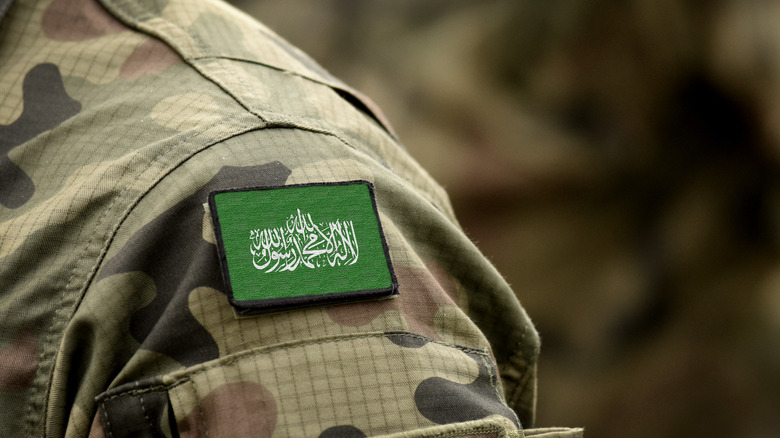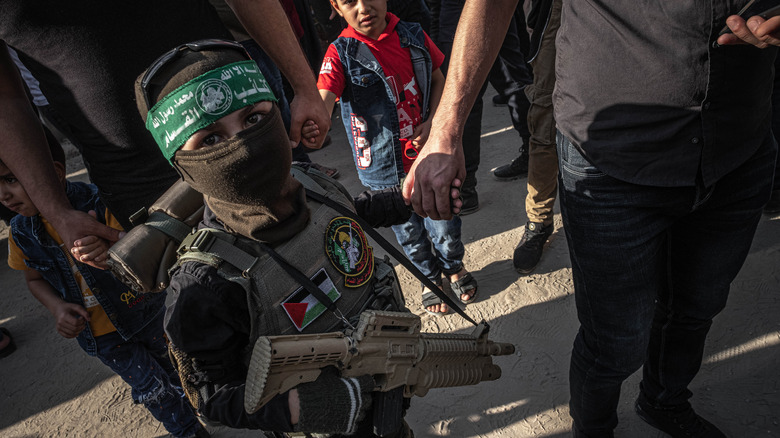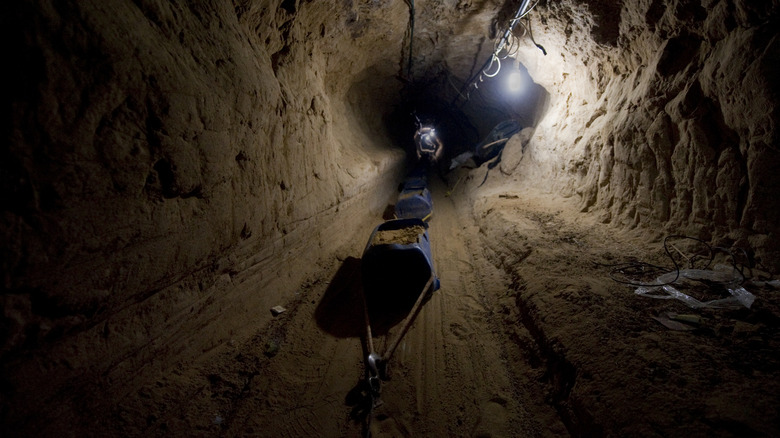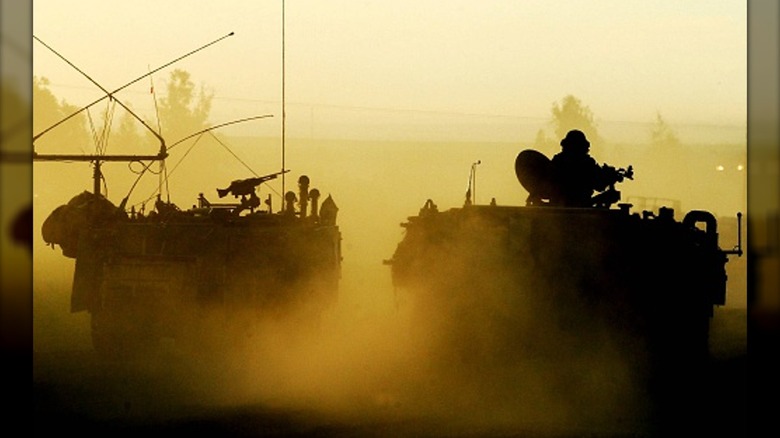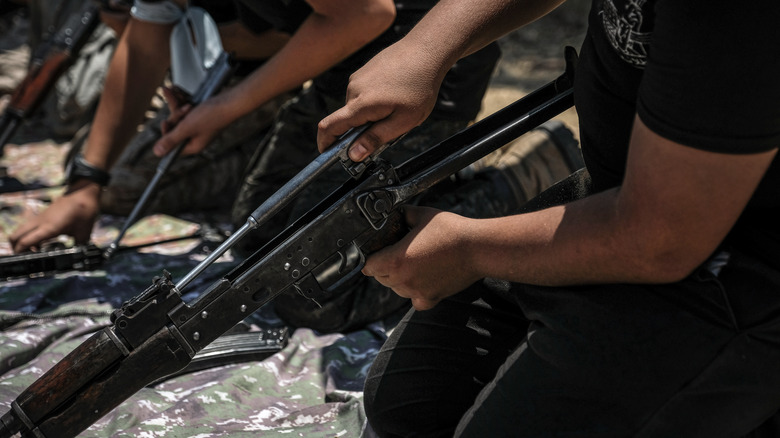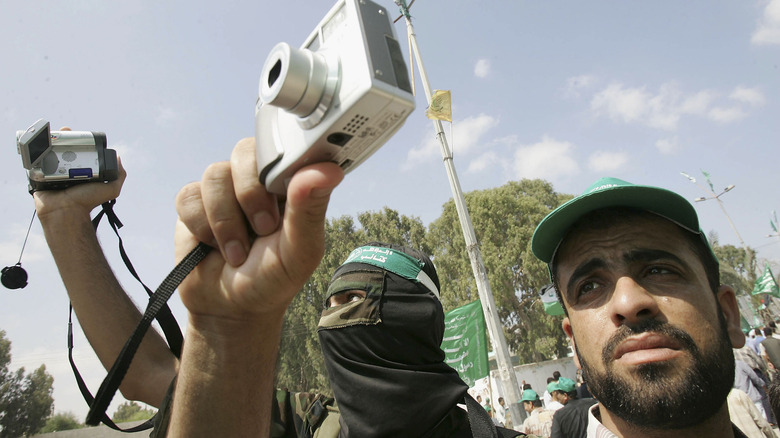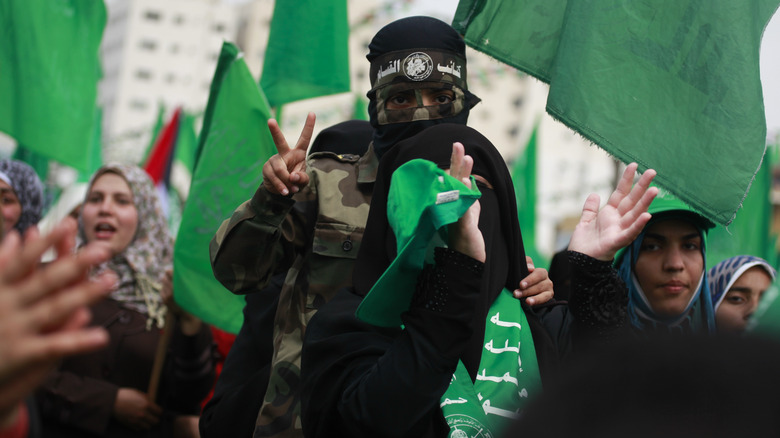The Untold Truth Of Hamas
Just as the news from the Ukrainian/Russian front started to fall from the headlines, there was another bloody conflict hurled onto the world stage. In October 2023, the world watched in shock as Israel was bombarded by one of the most devastating attacks in recent history, leading to a formal declaration of war. Behind the attacks was Hamas, a group known as a variety of things: In addition to being the Gaza Strip's ruling political party, they're also deemed an "Islamist militant group," and — according to the United States, the United Kingdom, and the European Union — a terrorist organization.
Hamas has long denied Israel's right to exist as a state, and although the whole thing is ridiculously complicated, here's the CliffNotes version. Israel was formed post-World War II, but when the state was formed, so did a conflict over who was going to get control over areas known as the Gaza Strip and the West Bank. Those pieces of land have changed hands a few times, — today, Hamas controls Gaza, and the West Bank is sort of controlled by their rival party, Fatah, and there's some Israeli occupation going on there, too.
Hamas' 2023 attack came along with a declaration that made it clear they intend to see Israel destroyed and the establishment of an Islamic-Palestinian state instead, and here's the thing: They have some seriously powerful allies, including Iran, Syria, Hezbollah, and the Islamic Jihad. So ... who, exactly, are they?
Hamas was founded by a Gaza refugee once captured then freed by Israel
So, how did all this get started? First things first: "Hamas" is actually an acronymfor "Harakat Al-Muqawama Al-Islamiyya," which translates to Islamic Resistance Movement, as per CNN. "Hamas" itself is Arabic for "zeal," and interestingly, it's also the Hebrew word for "evil," according to the Jewish Virtual Library. The terrorist group is defined largely by the belief that Israel doesn't have a right to even exist — instead, they believe that the area should be an Islamic territory. That kind of hate runs deep, but surprisingly, they haven't actually been around that long.
They were formed in 1987 under the guidance of Sheik Ahmed Yassin (pictured), a former leader of the Muslim Brotherhood. Yassin was born in a city that was eventually absorbed into what's now Israel, joined the Egyptian arm of the Muslim Brotherhood, and ended up in Gaza when Egypt clamped down on the organization. He rebranded as Hamas and quickly established a rhetoric of lauding the martyrdom of suicide bombers and other jihadists who acted in the interests of establishing Israel as an Islamic-held nation.
In 1989, Israel had actually arrested and sentenced him to life in prison. Yassin was in Israeli custody until 1997, when he was surrendered as part of an exchange deal that saw the release of two Israeli intelligence agents. Yassin survived several assassination attempts and was killed in a 2004 Israeli missile strike that was incredibly polarizing, particularly on the world stage.
How is Hamas different from other terrorist groups?
In 2006, six experts appeared on a panel called Intelligence Squared and argued (via NPR) just how Hamas should be classified. Daniel Ayalon, Israel's former U.S. ambassador, explained it like this: "They send terrorists strapped in explosives into markets, into pizzerias, into coffee shops, and into school buses and kindergartens. This is what they do. Are they a terrorist organization? If this is the definition of terror, they definitely are a terror organization." Thanks to the so-called War on Terror, many Americans might be used to thinking of terrorist organizations as hiding out in the desert, away from prying eyes. But Hamas is very, very different from other terrorist groups — like al-Qaeda — in a massive way.
The Center for Strategic & International Studies (CSIS) looked at how Hamas (and the Lebanese organization that's allied with them, Hezbollah), use technology and noted that in addition to being defined by the entities they attack, they're also defined by a strong nationalist presence. In other words, Hamas has established itself as ruling the people they claim to champion.
Members of Hezbollah hold seats in the Lebanese government, and in Gaza, Hamas is the government ... and that makes things tricky. CSIS says that because Hamas has positioned itself firmly in a place where it oversees much of Gaza's infrastructure, taking them out is much more complicated than just going in with guns blasting. They explain that even "target[ing] their IT infrastructure [risks] humanitarian consequences."
The development of Hamas Inc.
The Gaza Strip is about the same size as Washington, D.C., and it's home to about 2 million people. Blockades mean that no one is allowed to leave Gaza, and those who live there are dependent on Hamas for everything from food and medical care to entertainment.
Entertainment? Absolutely, and here's where things get weirder. In 2010, NPR took a look at some of the amenities in Gaza, including the beachside resorts and clubs that sit along the water. They found that the clubs — one of the only options people have for a little R&R — weren't just popular, but they were run by organizations with ties to Hamas. They interviewed one of the proprietors, who explained, "This is a joint venture between the government here [Hamas] and business people. There are two reasons: One is to make a profit, but the other is to ease the difficult life of the people in the Gaza Strip. So it's good for everybody."
Over the years, a variety of Hamas-connected businesses have popped up throughout Gaza — so many that it's referred to as "Hamas Inc." They include everything from shopping centers to wedding chapels, and it means that Hamas has made itself an unavoidable part of everyday life. Income gets rolled over into more assets, which means more income. Economist Omar Shaban said, "This business group has made a lot of profit out of controlling the economy, and this group is gaining more power every day ..."
Hamas vs. ISIS
Listen to social media or news outlets, and there's a good chance of seeing stories that compare Hamas to ISIS. Fox spoke to Seth Frantzman of The Jerusalem Post who said, "The videos of Hamas kidnapping women, children, and the elderly, and desecrating bodies are in some ways shocking to see but then again, Hamas has engaged in 30 years of grotesque terrorism and is a vicious, brutal, terrorist organization." But that's only part of the story, and it's worth mentioning the fact that in 2018, ISIS actually declared war on Hamas.
ISIS — particularly a branch of ISIS operating out of the Sinai peninsula — took issue with Hamas for a whole host of reasons: Hamas was seen as not prioritizing God's law when they got involved in elections, and ISIS also condemned them for their communications with Egypt and Iran. The Sinai branch of ISIS isn't to be trifled with, either — they were behind some of the deadliest terrorist attacks ever to take place on Egyptian soil.
While it might seem like the best course of action is just to let them duke it out amongst themselves, nothing is ever that easy. Columbia University's Tareq Baconi explained to NPR that the likelihood of an escalated conflict between the two was unlikely — in spite of the declaration — and clarified, "The two are not allies in the least. ... to even put them together as extremist organizations might overlook a lot of the differences that the two movements have."
Hamas recruits with shockingly diabolical methods
Hamas hasn't been around for very long, but they've cemented a foothold by recruiting to the cause and, in the process, radicalizing citizens. Matthew Levitt, director of the Reinhard Program on Counterterrorism and Intelligence at The Washington Institute, explained (in 2007), "Hamas's grassroots radicalization campaign on-the-ground is personal, eye-to-eye, and second to none."
In a nutshell: Life is miserable, people are angry, and angry people are primed to lash out at someone — and when Hamas can successfully convince those people that it's Israel that's the oppressor and the enemy, the seeds are planted. Hamas takes recruitment as a multi-pronged attack — not only do they appeal to the young men who are prime targets for transformation into suicide bombers (for example), but they also set up recruiters in a social services network that teaches families it's honorable to have a terrorist in the family, including in mosques and schools. A Gaza psychologist named Fadl Abu explained, "Martyrdom has become an ambition for our children. If they had a proper education in a normal environment, they won't have looked for a value in death."
What environment are they taught in? In 2001, photographs of a kindergarten graduation made the rounds. Children were dressed in military uniforms and as mini suicide bombers, and a young girl displayed hands covered in red paint, a nod to a lynching of two Israeli soldiers in Ramallah a year before.
For a long time, they were funded with help from a centuries-old practice
So, how did Hamas get the funding to establish the complete and total foothold they created over the Gaza Strip? In part, by utilizing some ancient history.
In 2014, NPR spoke with Israeli Defense Forces members who were in the know about a burst of shelling that had gone off over Gaza. Spokesman Peter Lerner said, "We're not willing for [Hamas] to come and meet us in our backyard. We want to meet them in theirs." By that, he meant taking out some of the many, many tunnels that snaked back and forth throughout the entire area, providing hidden passage from Gaza, through Israel, and even into Egypt. Entrances were often well-hidden, like the one that a Gaza City resident identified only as Kareen learned about when his house was destroyed. Also destroyed was a nearby chicken coop that he had thought was simply a chicken coop, and not at all the entrance to one of the tunnels.
The tunnels are massive, too, often fully lit and fully powered. Hamas has used them for smuggling in all kinds of products, up to and including cows and cars. Even more surprising is how old the idea is. Gaza, it turns out, is built on land that's incredibly forgiving to anyone who wants to tunnel beneath it, and references to secret tunnels go all the way back to 332 B.C. and Alexander the Great's siege of what was then a Persian-held city.
More recently, the tunnel networks have been used for even more nefarious purposes
In 2014, The Washington Post reported that Israeli forces were only then discovering how extensive the tunnels running to and from Gaza were, and they quoted a statement from the military saying that they were being used "to carry out attacks such as abductions of Israeli civilians and soldiers alike; infiltrations into Israeli communities, mass murders and hostage-taking scenarios."
Reports included those of Hamas squads who used the tunnels as entry points in missions to kill members of Israeli military patrols, and let's be clear: These aren't all small tunnels. One discovered by the IDF in 2013 took two years to dig, cost around $10 million, was 1.5 miles long, and outfitted with months' worth of emergency rations.
One Israeli man, Ben Hillel, spoke with NPR about the shock of learning that there was a tunnel entrance in his neighborhood: "Sometimes I do my Saturday walks, I go there, and never imagined that there would be, maybe on some paths that I was walking, an opening from where terrorists could just come and attack me. They had heavy ammunition ... so they probably wanted to enter one of the kibbutzim (communities) — in this case, our kibbutz — and kill people." The tunnels had been used in some high-profile abductions, including the capture of Israeli soldier Gilad Shalit. After being kidnapped in a raid that took six minutes, he spent five years in Hamas custody.
The Palestinian Authority is still at odds with Hamas
Hamas isn't the only ruling entity in the area, and like everything else there, it's complicated. Fatah is a reverse acronym for the Arabic phrase that translates to the Palestine National Liberation Movement, and they're the ones that were founded not long after the establishment of Israel. Hamas challenged them for authority, and it's gone back and forth a handful of times.
The bottom line is that no matter who's in charge, the ones who pay the price are the people living in Gaza. In 2018, the Los Angeles Times took a look at what was going on there ... or tried to, at least. They found that the Palestinian Authority was pointing fingers at Hamas, but at the same time, the PA was the one who essentially stopped paying Israel for electricity. The result? People were going around 20 hours a day without power.
So why, exactly, are Hamas and Fatah at odds? A very, very simplified explanation of that is Israel. While Fatah is in favor of negotiating peace with Israel and setting up defined borders, Hamas rejects any and all ideas of negotiating and even co-existing with Israel. Most recently, Gaza has fallen to Hamas, the West Bank has fallen to Fatah, and conflict has been pretty much everywhere.
Iran was found liable in the case of Hamas executing an IDF soldier
When Hamas launched a large-scale attack on Israel in late 2023, there were a lot of questions — including questions about where they got their funding from. According to what deputy national security adviser Jon Finer said (via CNN), it was pretty obvious that Iran was one of their biggest financiers ... without, he stressed, the presence of "direct information" about it. Israel has suggested that Hamas gets about $100 million a year from Iran, and in 2009, a U.S. court actually ruled Iran was liable for the kidnapping and killing of an Israeli soldier who also had American citizenship.
Nachshon Wachsman was abducted by Hamas in 1994, and the terrorist organization held him for several days while issuing demands for the release of Israeli-held Muslims. Israeli forces found out where he was being held and decided to attempt a rescue instead of a prisoner exchange, but Wachsman was killed in the botched attempt.
The Wachsman family went to court and sued Iran, saying they had provided Hamas with the financial backing they'd needed to kidnap and kill the 19-year-old soldier. Iran was found liable to the tune of $25 million, although it's unclear whether or not the family ever collected.
It's unclear how far Hamas' spy technology reaches
It's difficult to understand something like Hamas from the outside, and here's some important context: According to the Center for Strategic & International Studies, Hamas has a stranglehold not only on the infrastructure and economy of Gaza, but on the tech, too. That extends to programming and social media, and experts say that propaganda has been an integral tool in helping Hamas gain support and popularity. And propaganda is a powerful thing — Hamas targets residents not only with information that paints Israel as a hostile occupier who recruits every one of their citizens into the conflict, but they also target children with propaganda campaigns.
From an early age, children see programming where some of their favorite characters are brutally killed by Israelis, while those who fight for Hamas are infinitely glorified. And what about social media? That's been used, too, although it's not clear to what extent. In 2017, some soldiers in the Israeli Defense Force had been tricked into chatting with fake social media profiles created by Hamas and populated with photos taken from the profiles of unsuspecting women. The goal was to get them to reveal sensitive information, and the following year, things went one step further with the creation of apps — including dating apps and sports streamers — that also installed spyware and malware on phones when they were downloaded. Israel had insisted there was no damage done.
Why hasn't Israel just stomped Hamas out of existence?
Israel and Hamas have been fighting for years, so here's a question: Why hasn't Israel just ended Hamas once and for all? Israel has the backing of the United States, and it also has a massive military force that includes Merkava tanks and jets, including some sourced from the U.S. While no one's saying for sure whether or not they have nuclear weapons, they definitely have nuclear weapons. Hamas, meanwhile, is heavily armed but in a different way, one that relies on fast strike forces, mobility, and guerilla warfare.
According to the RAND Arroyo Center, it's complicated. There are two main things at play here, with the first being the fact that Israel doesn't actually want to have to be responsible for the Gaza Strip. It's a ton of people packed into a small space, with infrastructure completely dependent on Hamas, an unemployment rate of about half, an agricultural sector ruined by conflict, and a lack of access to basic necessities like clean water and sewage treatment.
But defeating Hamas and leaving Gaza to fend for itself isn't an option, either, with experts saying there's a high chance of Hamas being replaced with another organization that's just as bad, or likely worse. That's led to the long-standing method of dealing with Hamas — according to an Israeli defense analyst speaking with RAND, "We want to break their bones without putting them in the hospital." Complicated? Absolutely.




